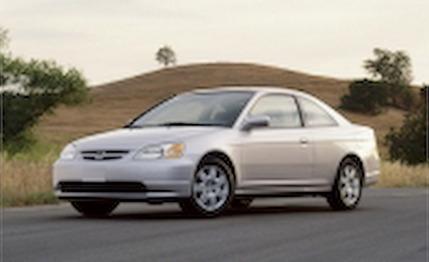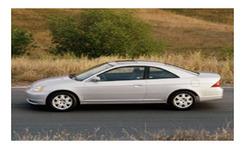 Road Test
Road Test
So, what should one expect at the introduction of Honda's seventh-generation Civic? A completely different car? No, of course not. The Civic evolves, it does not reinvent itself. Predictably, then, the claims for the new Civic range are mainly unsurprising.
After intense research into the needs of existing Civic owners, the car's interior space has been enlarged. The Civic moves from the EPA subcompact-category borderline safely into the compact category, with 2.6 extra cubic feet of interior volume and almost two extra inches of rear legroom. There are improvements in efficiency (all models are Ultra Low-Emission Vehicle certified), and improvements in performance (the new engine is up from 1.6 to 1.7 liters in size, thanks to a 4.4mm stroke increase, yet weighs less and takes up less space).
In DX and LX models, power increases from 106 to 115 horsepower, while torque increases from 103 pound-feet at 4600 rpm to 110 at 4500 rpm. In EX models (like the coupe you see here), which use Honda's VTEC-E engine, power remains unchanged at 127 horsepower at 6300 rpm, but the torque improves from 107 pound-feet at 5500 rpm to 114 at a more usable 4800 rpm.
Of the various changes made to the Civic range, the most surprising is Honda's adoption of a strut-type front suspension. The engineers say it helped them shorten the nose (by enabling them to raise the steering gearbox) and also improve impact-absorption performance. Good reasons both, yet we feel slightly disappointed at the disappearance of Honda's elegant and nimble double-control-arm setup. The 2001 Civic's trailing-arm, multilink rear suspension remains unaltered in principle, but its shortened trailing arms do without their forward-mounted locating links in the interest of space, making possible a flat, tunnel-less floor.
A more clearly differentiated Civic coupe debuts as a 2001 model alongside the sedan, sharing only the sedan's front clip, powertrain, and suspension. Despite its unique windshield, doors, and fastback bodywork, the coupe retains identical wheelbase and track dimensions (which tells you the floor pans are common). The coupe is, in fact, 0.1 inch longer overall than the sedan.
Even with a roofline 1.6 inches lower than the four-door's (the previous fastback stood just 0.6 inch shorter), the two-door's interior space is slightly better than in the preceding model. Unfortunately, the headroom in our EX test car was actually fractionally worse than in last year's car, due, we're told, to a raised seat hip point (intended to ease access) and not the sunroof that comes standard on EX models.
But since the car fulfills the needs of a hypothetical buyer named Jennifer (according to Honda's marketing types, who should know), there ought to be enough room unless this particular Jennifer is atypically tall for a woman.

But vast interior space isn't what coupes are about, and here the decision to better differentiate the Civic models will probably pay off. With the longer door and lower roofline, the fastback has a more steeply raked A-pillar, a more wedge-shaped glasshouse, and a shorter roof. Its grille has a single crossbar instead of two and a body-color top-grille garnish rather than the four-door's chrome strip.
At the rear, a lower taillight position and an angular cut-line set two-doors apart from the other Civics. Inside, you find the same new, large instrument panel and rationalized center-console design utilized across the model line. The moldings are attractively designed, with contrasting textures and titanium-colored trim highlights to help deny the car's low-budget origins.
As can be expected from a new Civic, the structure is stiffer in both torsion and bending, and a lot of attention was paid to silencing and smoothing the car's roadgoing dynamics, as well as to improving its crash resistance. The use of high-strength steel in parts of the body, along with some clever techniques for transferring impact forces into the floor, have resulted in expectations for excellent crash ratings, including a four-star SINCAP rating (for side impacts), a five-star NCAP rating (for frontal impacts), and a "good" Insurance Institute for Highway Safety rating (for offset frontal collisions).